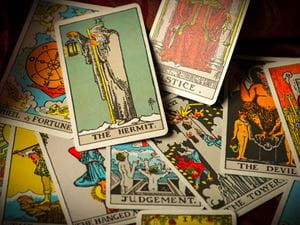
Tarot cards are one of the most famous methods of reading the future. They are enshrined alongside crystal ball reading and palmistry, or palm reading, as one of the most iconic methods of fortune telling in the West. Modern tarot cards have 78 cards divided into two major groups called arcana, meaning “secret.” There are 22 major arcana or trump cards and 56 minor arcana cards. These are then divided further into four suits. The four suits of tarot cards are cups, pentacles or coins, wands or staves and swords. Each suit has four court cards: page, knight, queen and king. Each suit also contains one ace card and nine pip cards numbered two through 10.
To anyone who plays modern card games, this set up sounds rather familiar. A deck of cards divided into four distinct suits, each of which has an ace, nine numbered cards and several face cards. While Pages do not exist in modern playing cards, the king and queen remain, and the modern jack card could be the substitute for the tarot knight. The similarity between the mystical tarot deck and the modern deck of playing cards is unsurprising. This is because tarot cards were originally used as playing cards.In the mid-15th century, tarot cards were called trionfi, tarocchi and tarock cards. The designs of the cards varied across Europe as did the suits. Each deck, however, had four suits comprised of 14 cards. Each suit contained ten pip cards numbered 10 through one or 10 through two with an ace acting as one. Each of the four suits also contained four face cards: a king, a queen, a knight and a jack, knave or page. In fact, modern tarot cards are still used as playing cards in parts of Europe to play games such as Italian tarocchini and French tarot. In English speaking countries, however, tarot cards are used almost exclusively for divination.
Some modern users of tarot cards insist that the cards originated in ancient Egypt or with the Kabbalah, an ancient, esoteric Jewish school of thought aimed at explaining the relationship between an unchanging, eternal and mysterious Ein Sof, or Infinity, and the mortal and finite universe of God’s creation. Despite the interest of the modern occult and New Age practitioners in an ancient root for tarot cards, there is no real evidence that tarot cards originated earlier than the final years of the Middle Ages.
The earliest known set of tarot cards was created in the 14th century. The popularity of card games had soared after Mamluk game cards were brought to Western Europe from Turkey. The first tarot cards were likely used in a game that became popular in Italy, tarocchi appropriati. In Italian tarocchi appropriati, players were dealt random cards. The players then wrote poems about the cards based on the thematic associations of the cards.
Another possible origin for tarot cards was to play a game rather similar to modern day bridge. Wealthy Italian families would commission artists to create hand-painted decks called “cards of triumph,” or “carte da trionfi.” These cards were marked with suits of cups, swords, coins and polo sticks and had a court consisting of three males, one of which was a king. Later decks incorporated queens, trump or wild cards and the Fool to make a deck of 78 total cards.
While it may surprise modern people who associate tarot cards with divination, witchcraft and the occult, tarot cards in their original time were seen as saturated with Christianity. Each card was patterned to be covered in Christian imagery. This only began to shift after the cards became increasingly associated with and used for divination and fortune telling.
The mystical and magical associations with tarot cards had put down roots by the mid-18th century and spread outside of Italy. A French writer, Antoine Court de Gebelin, claimed that tarot cards were based on a holy book written by ancient Egyptian priests. The cards were then brought to Europe by gypsies. While this certainly gave tarot card fortunes more credibility, tarot cards predate gypsies in Europe, and ethnic gypsies were not from Africa at all.
As time passed, tarot cards became increasingly associated with the occult and the modern French-suited playing card came into major prominence in English speaking countries. The 52 card deck of hearts, diamonds, clubs and spades is arguably the closest to the original Mamluk playing card deck that sparked off European interest in playing cards in the first place. Tarot cards, however, continued to be manufactured and used. They are still used as playing cards in parts of Europe today, and the mystical associations with tarot cards has only increased some people’s interest in them. As such, tarot cards live on in both their original and more magical forms even as modern playing cards rise to challenge them on both fronts.

